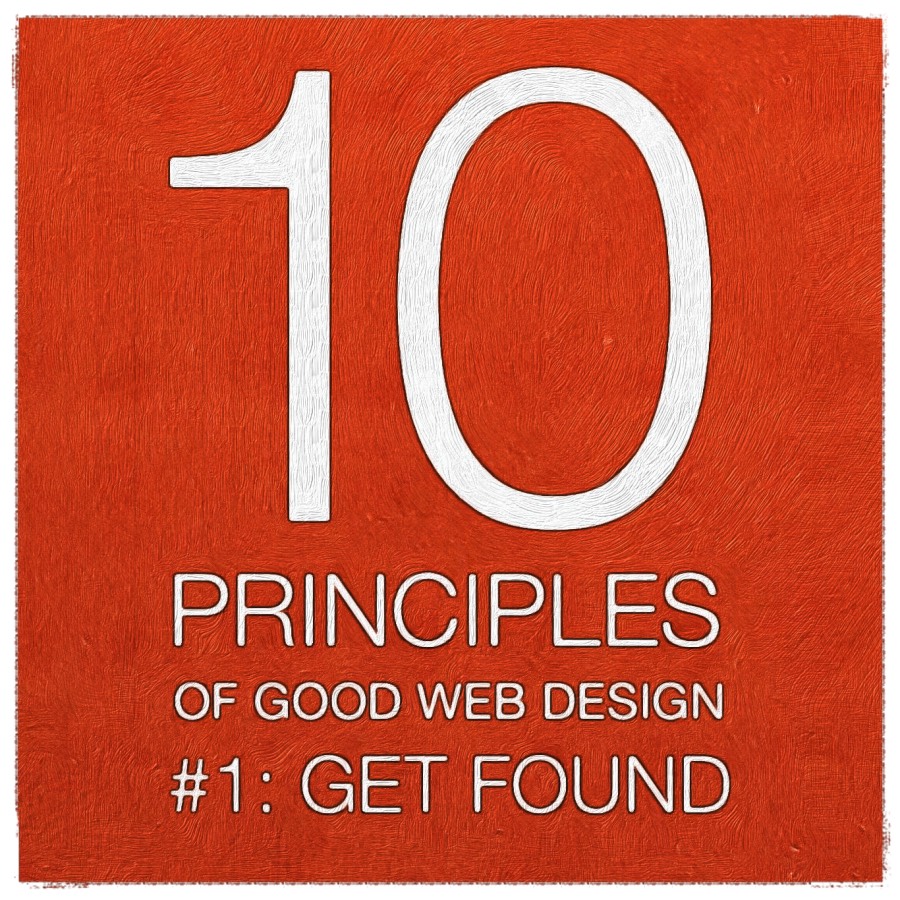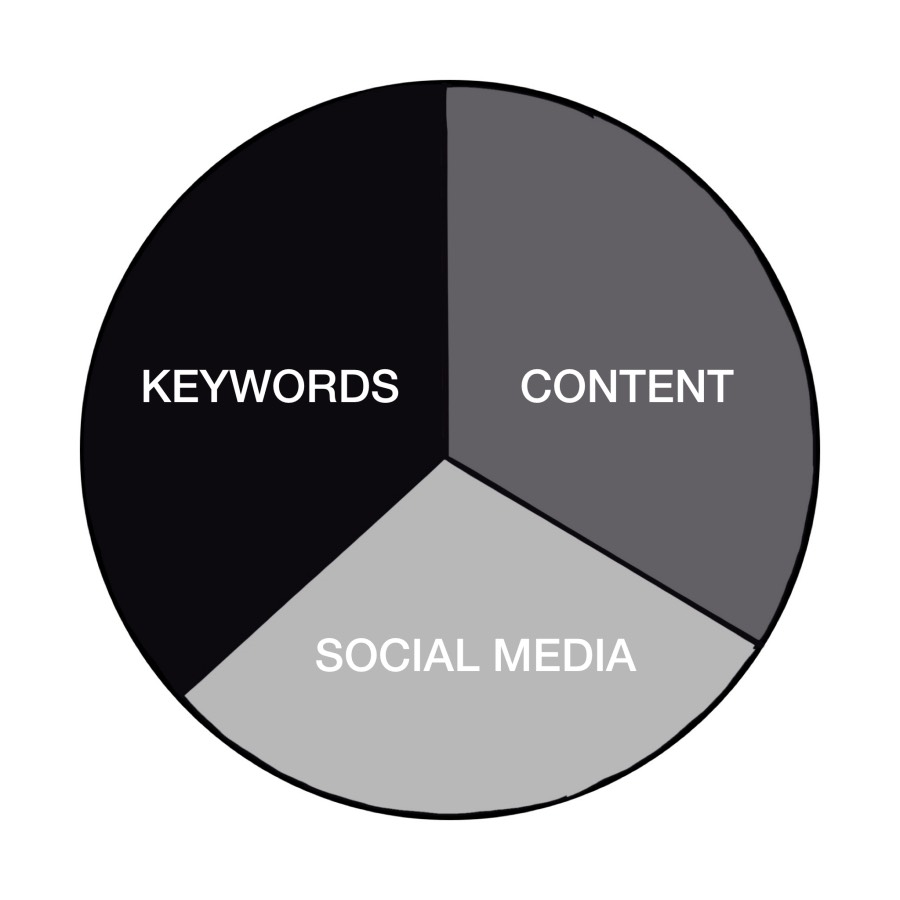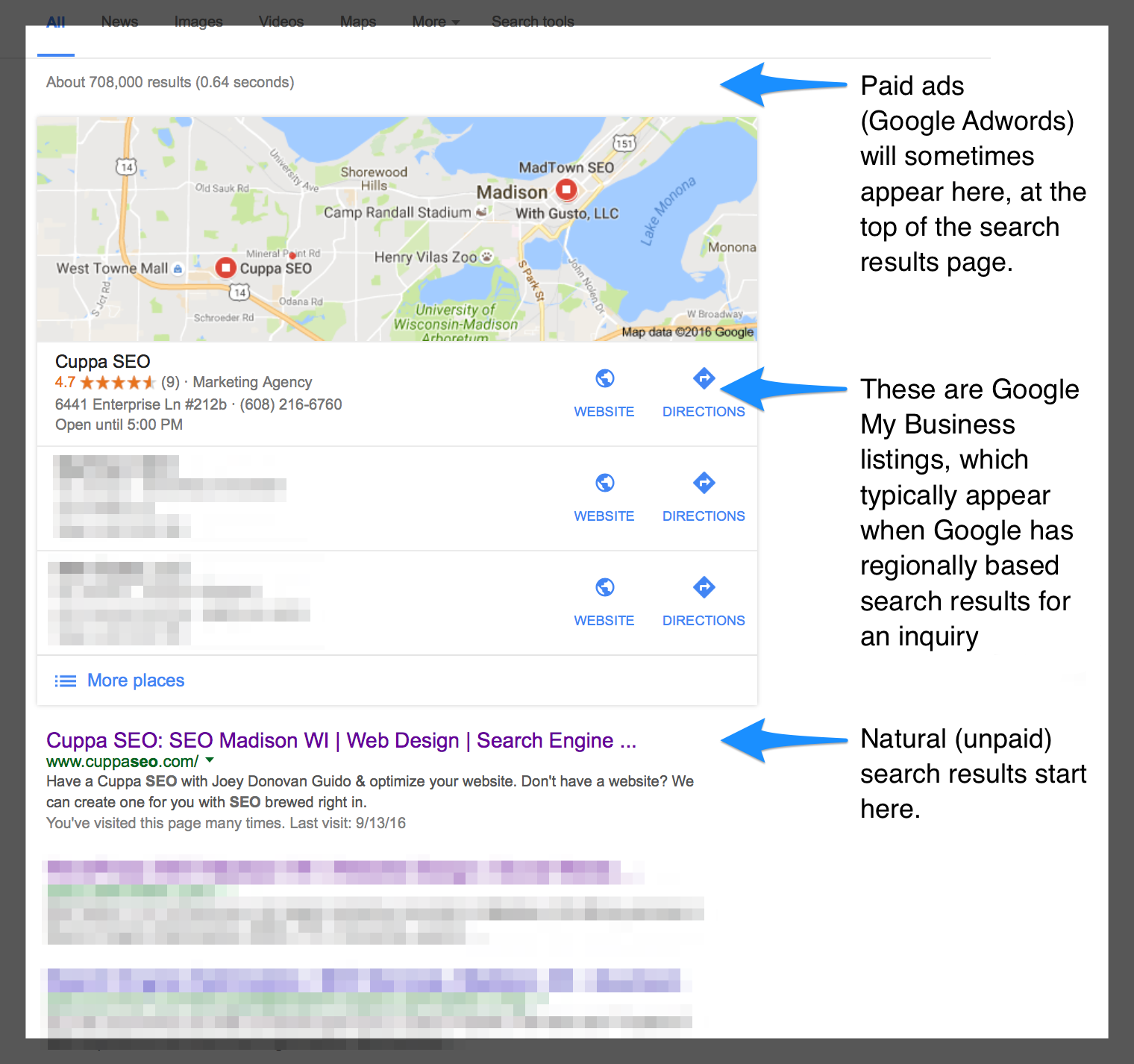 Good web design helps get your website found.
Good web design helps get your website found.
High-level search engine optimization (SEO) needs to be brewed into every nook and cranny.
SEO DEFINED
In a nutshell, SEO is a process that has the ability to improve the natural ranking of your website or blog in search results — leading to increased traffic, sales, customer engagement and overall growth. SEO is the connector between someone who’s making a specific query on Google (or another search engine) with websites and/or blogs that contain relevant information pertaining to the query.
We’ve all performed countless searches, right? And on the surface, it seems pretty simple. Someone performs a search — say with the keyword “plumber” — and Google looks for and delivers results that are relevant to this keyword phrase. This, in and of itself, is no big news. But the question is, how does Google decide which results to list? And why do some sites or blogs rank higher than others?
Search engine optimization is a large part of the answer to these questions. It plays a critical role in determining where a website or blog ranks in the natural (also referred to as “organic”) search results.
Let’s take a deeper look at how this works, and learn about …
THE SEO PIE
Part of search engine optimization is the selection and strategic implementation of optimal keywords into your website content. Keywords account for approximately one-third of the SEO pie — a significant amount, for sure, but not a complete package by any means. In the past, keywords were a bigger piece of the pie. Then blogs and social media came along.
Now, effective SEO is broken into three major parts: keywords, content and social media. Together, they make up the SEO pie.
Keywords
You’ve probably heard the term “keywords” referred to more than once in relation to your website. And although you may know they’re a critical element in SEO, you may be wondering exactly what keywords are. Let’s take a look!
Keywords are terms or phrases that, when implemented into your website, can help connect you with people who are looking for what you do. In other words, when the keywords you use on your site are in alignment with the search terms people use to find the specific products or services you offer, there’s a better chance Google will present your website higher in the search results.
For example, if you were a dentist in Los Angeles, CA, phrases like “Dentist,” and “Dentist Los Angeles” would be good keywords because they’re actually terms people use to find a dentist in Los Angeles, CA.
That said, the quality of your keywords makes a big difference in how effective they are. Many factors go into determining which keywords are best for your website and blog, including:
- The size of your site
- How long it’s been around
- How many people are searching for a specific keyword phrase within the region(s) where you do business
- How much competition you’ll be facing for that particular keyword or keyword phrase
- How relevant a keyword phrase is for your business or organization
Now that we’ve got a basic definition in place, let’s dive deeper for a greater understanding of keywords.
Keyword Hierarchy
Let’s start with what I call “keyword hierarchy,” something I’ve developed over the years to help identify optimal keyword (and keyword phrase) usage.
Essentially, when optimizing content, you don’t want to have just one keyword phrase that you hammer on ad nauseam. Instead, you’ll want to create a well-rounded list of keyword phrases for every web page and blog post. Depending on the topic and the content length, this list could include 3–5 keyword phrases or more than a dozen.
No matter the length of the list, make sure every single phrase is relevant to the topic, service or product you “discuss” in your content. Some call this “topic-based SEO,” among other things, but I just call it good writing.
For instance, if you have a pet food store that caters to dogs, well-written copy won’t be limited to dog food. You’ll want to talk about food for puppies as well as for older dogs … about different breeds of dogs and what foods might be best for them … and don’t forget dog treats! You might even want to cover how the foods you sell affect not only canine general health, but also canine dental health. You get the idea. Well-rounded keyword usage helps produce well-rounded content that’s good for the human eye — and for SEO.
Primary, Secondary & Semantic Keywords
Once you’ve developed your list of keywords for a particular web page or blog post, you’ll need to decide which are primary, secondary and semantic, respectively.
- Primary Keywords: As “primary” indicates, these are the main keywords in your content. Sometimes you’ll determine them in advance; other times your organically written content will dictate them.
- Secondary Keywords: Used less often than primary keywords, these are still specific to the website page or blog post you’re optimizing.
- Semantic Keywords: Used only once or twice at most, these still play an important role in “rounding out” the relevance of the content.
As you can see, semantic and secondary keywords play a supporting role in the optimization of content. They’re good to use, but they don’t have the oomph that a main keyword has, typically for three reasons: 1) they have low search numbers; 2) they have high competition; 3) they’re not the main topic of the page, but they work tangentially to support the main topic. An SEO novice might use secondary and semantic keywords as main keywords — or might overlook them completely. In Part 2 of the book, we’ll dive deeper into primary, secondary and semantic keyword usage.
Long-tail Keywords
This is a fancy term for using keyword phrases that are typically three or more words long. Very often, what makes a keyword phrase long-tail is the fact that it has some “definers” or “qualifiers” in it, making it very specific.
For example, “dentist” is most likely going to be a strong keyword, no matter where your dental office is located. But I’ll bet it also has very high competition. Adding qualifiers to the keyword — “Dentist Madison WI” for example — makes it more specific and might have less competition from other area dental offices.
Case Study — First Choice Dental
First Choice Dental (FCD) is a local dental chain in Dane County, WI. In our work together, Cuppa SEO optimized dozens of First Choice Dental’s website pages and blog posts. Part of this optimization included implementing long-tail keywords in exactly the way I described above.
Take a look at the actual numbers (as of this writing), and you’ll see that the long-tail keyword is preferred over the short-tail keyword:
Keyword Phrase: Dentist
Monthly Search in Madison WI: 1,000
Competition: High
FCD Rank: 2nd on page 1
Keyword Phrase: Dentist Madison WI
Monthly Search in Madison WI: 880
Competition: Medium
FCD Rank: 1st on page 1
As you can see, FCD ranks well on Google’s natural search results for both phrases, but it ranks better for the long-tail keyword: It’s easier to crush weaker competition!
A nice thing about long-tail keywords is that they often contain multiple short-tail keywords. In the example above, “Dentist Madison WI” actually contains, “Dentist,” “Dentist Madison,” and “Dentist Madison WI,” so it really packs a punch.
Keyword Density
The term “keyword density” is worth a quick mention here. Keyword density is what it sounds like: the number of times (density) a keyword phrase appears on a page compared with the total number of words on the page.
Over the years, I’ve heard SEO experts argue that a keyword phrase needs to occur a certain percentage of the time to be considered an actual keyword. Through testing, I’ve found this untrue. Although a keyword phrase typically needs to appear more than once within the content to be taken seriously by Google, it DOES NOT need to appear a certain percentage of the time. That’s no way to optimize — and that’s no way to write good, relevant content. In Part 2 of this book, we’ll take a step-by-step look at exactly where to implement your keywords, which is a critical component of solid SEO practices.
Another point of view is that it’s context — not keyword occurrence rate — that’s important. As you might have guessed, I agree that context is extremely important. When you’re writing rich, relevant, helpful content, that’s a third of the SEO pie. Of course, for content to meet all of these requirements, it has to make sense within the context of the page it’s on as well as within the website or blog as a whole. Let’s talk a bit more about content …
Content
In plain terms, content is the copy (words) and imagery found on your website and blog. And, when it comes to content and SEO, there are two important factors to keep in mind.
The Relevance Factor
Just like a human, Google is judging your content and determining whether it’s rich and relevant or boring and “thin.” Rich, relevant content helps each of your web pages and blog posts gain more authority in Google’s eyes, which means ranking higher in search results. It also increases credibility and engagement with actual people, too.
Thin content accomplishes the opposite, and it might lead your website or blog toward what I call the “black hole of Google Panda” — never to be found in organic search results. The good news is that if you take the time to create quality content, your site is already partially optimized!
The Freshness Factor
Freshness is an important factor in how well your website ranks in natural search results on Google. But where you add that fresh content to your site is just as important as how rich, relevant and useful it is.
Many novice SEO practitioners will tell you that the best way to inject new content into your site is to “freshen up” your homepage and subpages with new copy and keywords — sometimes on a monthly basis.
Taking this approach on a well-optimized site will most likely backfire.
Why? Because once your site is well optimized, changing the SEO on your homepage or subpages is similar to changing your phone number every month: It makes no sense. Just as your customers depend on your phone number as a means to reach you, Google is depending on your optimized content to find you and connect you with individuals who need you. Once you change the SEO on a page, the result can often be going back to square one — losing some or all of your page authority (credibility) with Google.
In other words, unless something changes — like a service or product — or one of your pages starts to perform poorly, you’ll want to leave well-optimized content alone on your home page and subpages.
So, if you need fresh content, where does it come from?
Fresh Content Comes from Your Blog
Use that blog of yours to generate the fresh content Google — and your viewers — are looking for. Adding a minimum of one blog post per week can do wonders for your “freshness factor.” Why? Because every time you publish a blog post, Google notices and gives your website credit for having some new, fresh content.
And, by the way, each blog post is excellent fodder for your social media efforts, too. Speaking of which, let’s review …
Social Media
Your social media efforts round out the SEO pie. Just as with your website and blog, you’ll want to optimize each and every social media post you publish. This means you’ll want to incorporate relevant keywords into each post.
It’s important to note that platforms such as Facebook, LinkedIn and Twitter can help with business growth and relationship development, but it’s Google My Business that holds the lion’s share of SEO value in the world of social media.
In other words, consistently publishing posts through your Google My Business page can play a significant role in boosting your overall online authority. Google has made itself extremely self-important in the social media world. Like it or not, Google My Business is an extremely critical platform in the SEO equation. My advice: Use it to your advantage.
At this moment, you might be feeling the urge to jump ahead to part 4 of this book and begin implementing all of the social media optimization strategies. Resist the urge! Remember, your online marketing will be most effective if you stay true to implementing the strategies in this book in the order they’re presented.
SEO Pie Recap
Addressing all parts of the SEO pie helps Google identify what you do, so when an individual searches for your services or products, you’ll more likely show up closer to the top in natural search results as Cuppa SEO does in the following example. The better optimized your website, blog and social media efforts, the better chance you have of ranking high in these search results, which look like this …
Want more tips and insights from Cuppa SEO?


